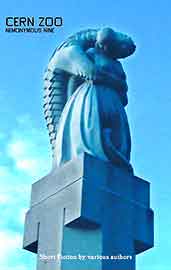Edited by DES LEWIS (Megazanthus Press; 2009)
Another Nemonymous anthology, meaning another weird and fascinating compendium of horror, science fiction and general oddness. Having read the previous Nemonymous compilation CONE ZERO, I’ve learned the one thing you can reasonably expect from these books is the unexpected. CERN ZOO doesn’t have the overall impact of CONE ZERO (the winner of at least one prestigious award and one of my favorite books of 2008) but its contents are every bit as varied and unexpected as you might expect.
As per the Nemonymous model, the names of CERN ZOO’S 24 authors are listed on the back cover, but not in the same order as the contents; we won’t learn until the subsequent volume who wrote what. Many of CONE ZERO’S contributors recur (A.J. Kirby, Bob Lock, Dominy Clements, Stephen Bacon), though most of the present book’s writers (including such names as Rosalind Barden, Gary Fry, Geoff Lowe, Lee Hughes, A.C. Wise, Lesley Corina and Brendan Connell) are new. The apparent theme is the words of the enigmatic title, but I had a difficult time discerning that in many of the stories.
“Dead Speak,” a science fictionish lark about a potentially deadly scientific experiment, begins the collection; it’s a solid work, but what struck me most about the piece was this macabre description: “red liquid spread across the white tablecloth like blood spurting from a severed artery.” The book concludes with “Fragment of Life,” concerning a man who thinks he sees a boy living in the ostensibly deserted house next to his own. In between we get stories about a Spanish king in search of a mermaid, a party that gets out of hand after its host decides to ban violent video games, a place that buys unwanted memories, a factory whose objects steal peoples’ shadows, a girl who finds peace by settling down with an unearthly creature, a spider-like critter that devours peoples’ thoughts, and a man who can communicate with the souls of dead animals. Yes, it’s that kind of book!
I’m not quite sure what to make of “Parker,” an odd three-page ditty about a writer’s switch from working on a computer to writing by hand, or “Salmon Widow,” an enigmatic, somewhat experimental piece about a woman named Salmon, her fisherman husband and their fateful stay at a posh English resort. I was also puzzled, though in a good way, by “Pebbles,” wherein a boy becomes intrigued a pebble collecting girl on a beach. It’s a haunting tale whose ambiguities compliment a sense of dark, possibly supernatural menace. There’s also a bad joke of a story: “Dear Doctor,” a two-page letter from a sword-swallower to his doctor complaining of a sore throat!
The book’s best stories? Those in my view are “Artis Eterne” and “The Lion’s Den.” “Artis Eterne” is an eerie evocation of faith and nostalgia, with the protagonist recounting standout events revolving around a neighborhood bar and a mysterious patron who was always there. “The Lion’s Den” is related by a zoo worker whose life and occupation are horrifically impacted by a strange boy who one night inexplicably enters a lion’s cage. The sense of brooding mystery of this story is remarkable. I also particularly enjoyed “The Rude Man’s Menagerie,” about a woman menaced by chalk drawings, and “Strange Scenes from an Unfinished Film,” about a horror film buff who gets his hands on a VHS copy of rare footage, with horrific consequences.
Obviously CERN ZOO is a mixed bag in every sense of the term. But that seems to have been at least part of the aim of editor Des Lewis (who as usual goes unaccredited). Needless to say, he’s succeeded.
See Also CONE ZERO, NULL IMMORTALIS

